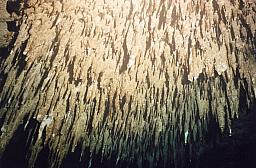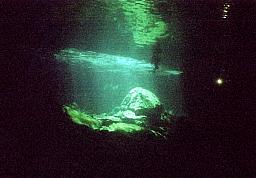Cenote (Cave/Cavern) Diving in Mexico
Thursday, March 27, 2003
020-30.000 N087-13.320 W
Ahoy from Puerto Adventuras where we've just returned from two Cenote dives!
 In
the distant past the Peninsula of Yucatan was under the ocean and was covered by
reefs and marine life. During the ice ages the water level dropped killing the
reefs and leaving behind layers of silt and marine fossils. These layers were
made of highly porous limestone. When it rains, the water percolates down
through limestone, dissolving it and eventually forming underwater rivers and
tunnels. Eventually these rivers formed caves lined with stalactites and
stalagmites.
In
the distant past the Peninsula of Yucatan was under the ocean and was covered by
reefs and marine life. During the ice ages the water level dropped killing the
reefs and leaving behind layers of silt and marine fossils. These layers were
made of highly porous limestone. When it rains, the water percolates down
through limestone, dissolving it and eventually forming underwater rivers and
tunnels. Eventually these rivers formed caves lined with stalactites and
stalagmites.
A Cenote (pronounced say-no-tay) is a part of a cave where the ceiling has collapsed creating a natural entrance into the underground system. The word cenote means sacred well and the Mayans considered the cenotes to be entrances to their mythical and spiritual underworld.
There's probably a dozen cenotes between Puerto Adventuras and Tulum. To dive in these you need to be a certified cavern or cave diver, or go with a cave certified dive master. It's definitely more expensive than normal diving, costing between $100 and $130 for a 2 tank dive. After checking the local dive companies and some of the ones in Playa del Carmen, we chose Abyss divers (www.abyssdiveshop.com). After seeing some of the other companies in action, I felt like we had chosen very well. We only had 1 other diver and our dive master, Diego Lugo, was extremely knowledgeable, friendly, and spoke great English. He claims to have dove one of the cenotes over 800 times!
 We
were picked up at the entrance to Puerto Adventuras and we drove about 5 km to
cenote Chikin Ha. While enroute we went over rules and restrictions present
while diving in an overhead environment, which is one where you can't always
make a direct ascent to the surface. Quickly these are that you're never more
than 200' from an opening (implying that you may be under an overhead for 400');
there's a guideline that you can follow; you carry at least 1 light; you turn
around at 1/3 of your starting air; there are no movement restrictions; no
decompression; a max depth of 70 feet; and there's a maximum of 4 divers per
guide. Cave diving and cavern diving are almost identical, except that if you
violate one or more of the above, you're considered to be doing cave diving.
Cave diving certification is extensive and expensive, requiring at least 16 cave
dives of increasing difficulty.
We
were picked up at the entrance to Puerto Adventuras and we drove about 5 km to
cenote Chikin Ha. While enroute we went over rules and restrictions present
while diving in an overhead environment, which is one where you can't always
make a direct ascent to the surface. Quickly these are that you're never more
than 200' from an opening (implying that you may be under an overhead for 400');
there's a guideline that you can follow; you carry at least 1 light; you turn
around at 1/3 of your starting air; there are no movement restrictions; no
decompression; a max depth of 70 feet; and there's a maximum of 4 divers per
guide. Cave diving and cavern diving are almost identical, except that if you
violate one or more of the above, you're considered to be doing cave diving.
Cave diving certification is extensive and expensive, requiring at least 16 cave
dives of increasing difficulty.
When we got to Chikin Ha we were taken on nature walk to see the area and understand the geography. We walked through jungle on a well maintained path. Along the path there were ravines which dropped to holes which disappeared into the ground. We descended into one of these ravines and found a large cavern filled with clear water. The cavern was probably 150' wide and the roof of the cavern was probably 50' up. There were steps to get in/out of the water and you could see a guideline that lead into the cenote. After checking out the dive site we hiked back to the van, climbed into our gear and hoofed it back down to the cenote.
One thing that was very nice was how little weight I needed. Normally I wear 12 lbs of weights when I dive in the ocean without a wet suit. Here I was in a shortie wet suit (which adds buoyancy) but I was only wearing 7 lbs due to the fresh water! It is cool...about 72-75 degrees, so you need some thermal protection.
 Sue,
who is definitely claustrophobic, was apprehensive, but willing. The water was
beautifully clear and had a bluish tint to it. Huge boulders studded the bottom
as we swam along the guide line. Fairly quickly we left daylight and the lights
of our flashlights lit up the tunnels that we swam through. At times beams of
sunlight from overhead holes would slice through the water. One could almost
believe that these were blue lasers due to their intensity and sharp focus. The
effect was magical, with the whole area glowing blue.
Sue,
who is definitely claustrophobic, was apprehensive, but willing. The water was
beautifully clear and had a bluish tint to it. Huge boulders studded the bottom
as we swam along the guide line. Fairly quickly we left daylight and the lights
of our flashlights lit up the tunnels that we swam through. At times beams of
sunlight from overhead holes would slice through the water. One could almost
believe that these were blue lasers due to their intensity and sharp focus. The
effect was magical, with the whole area glowing blue.
The halocline is another effect that I had never seen before. This is where fresh water from the cenote meets salt water from the ocean. The salt water is denser and sinks to the bottom and the fresh water stays on top. This is a distinct layer and you can see the refraction change when you pass through it. If someone is swimming in front of you and mixes the layers, it's almost like you're looking through a bubbled bathroom window. Simply moving to the side or up will get you out of the effect. Also, if you take you light and shine it at the layer, the beam spreads out almost 180 degrees and casts bright bands along the walls. Quite the light show!
 Over
and over the dive took us up and down. There weren't many interesting object to
look at, but the light shows were fantastic. After about 45 minutes we surfaced
with tons of air, hiked back to the van, had lunch, and then headed off to the
Taj Mahal cenote which was just a few more km down the road. When we got there
we were happy to see that the other dive companies were finishing up and we'd
have the place to our selves. We suited up and headed down to the cenote.
Over
and over the dive took us up and down. There weren't many interesting object to
look at, but the light shows were fantastic. After about 45 minutes we surfaced
with tons of air, hiked back to the van, had lunch, and then headed off to the
Taj Mahal cenote which was just a few more km down the road. When we got there
we were happy to see that the other dive companies were finishing up and we'd
have the place to our selves. We suited up and headed down to the cenote.
Taj Mahal was much more interesting than the Chickin Ha. The ceiling and floor were lined with stalactites and stalagmites and there were all kinds of fossils imbedded into the walls. The terrain was extremely varied and it was wonderfully clear. At several locations brilliant beams of light illuminated the water and the floor. We surfaced in two underground caverns and watched bats fly among the stalactites. Awesome! All too soon we were done and back to reality. Sue, despite her claustrophobia, had a great time and I can only hope that my photos captured the splendor of these dives.
-- Geoff & Sue
Log ID: 352
Photos/Video:
To receive these logs via e-mail, please subscribe to the mailing list or you can follow us on FaceBook by clicking: